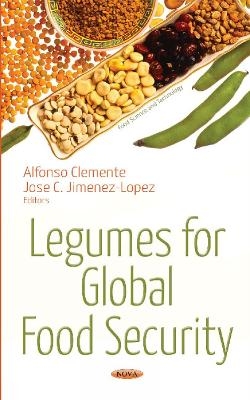Legumes are an essential food crop and a relevant source of plant-based proteins for humans around the globe, and particularly in developing countries. Grain legumes are highly nutritious and have excellent nutraceutical properties; these are affordable foods contributing to household food safety and, as a result, offer great hope and opportunity for achieving future global feed and food security. There is no doubt that facing an increasing world population over the next 50 years, the implementation of future research strategies and programs on legume productivity by harnessing scientific expertise and emerging molecular tools is of great importance to develop high-yielding legume varieties with enhanced multiple beneficial qualities and to tackle human diseases, using both traditional breeding and biotechnology methods. Grain legumes enhance the sustainability of cropping systems by increasing soil fertility through biological nitrogen fixation. They are adapted to diverse climates, thus providing solutions to climate change. Improved varieties having heat and drought tolerance are able to overcome abiotic stresses, offering even more hope for crop stability in vulnerable regions as well as against pests and diseases that cause significant production losses, making them a central component of sustainable intensification efforts on millions of small and poor farms. This book provides an innovative contribution for people working with legumes in different fields such as agriculture, crop improvement, health promoting aspects, pest and disease fighting, and the overall scientific community, giving them an updated and global vision about the importance of legumes for the worlds greatest challenge in global feed and food future under a sustainable agriculture. The book includes the following topics: Legume germplasm; Increasing legume production to improve food security, nutrition food safe, environmental benefits and economy; Legumes and climate change; Pests and disease management; Nutritional improvement of legumes; Legumes health benefits; Legumes allergy research.
Preface; Grain Legumes in Spain: The Current Situation & Perspectives; Legumes & Climate Change; Diversity & Conservation of Wild & Primitive Common Bean Germplasm & Their Associated Rizobia in the Andean Region; Trichoderma Species as Biocontrol Agents in Legumes; Participatory Action Research Methodologies to Advance Legume Productivity; A Seed Trait Studied by Gregor Mendel in Pisum sativum L. (Pea): Potential Prevention of Type 2 Diabetes; The Nutritional & Nutraceutical Values of Some Ready-To-Eat Expanded Legume Products; Forage Legumes with Improved Nutritional Value: Condensed Tannins to Avoid Pasture Bloat; Legume Allergenicity: The Effect of Food Processing; The Function of Conglutin Proteins from the Sweet Lupin Group in Food Allergies; Index.
| Erscheinungsdatum |
31.01.2018
|
| Verlagsort |
New York |
| Sprache |
englisch |
| Maße |
155 x 230 mm |
| Gewicht |
528 g |
| Themenwelt
|
Technik ► Lebensmitteltechnologie |
| ISBN-10 |
1-5361-2265-3 / 1536122653 |
| ISBN-13 |
978-1-5361-2265-7 / 9781536122657 |
| Zustand |
Neuware |



